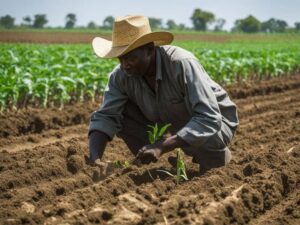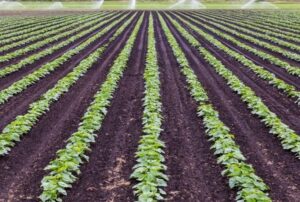5 Types of Soil and Their Characteristics You Need to Know
When it comes to understanding the environment around us, types of soil and their characteristics are essential to know, especially for anyone involved in farming, gardening, or land management. Soil plays a vital role in plant growth, water drainage, and nutrient availability, making it one of the most crucial elements of agriculture. In this comprehensive guide, we will cover the five most common types of soil, their characteristics, and how these attributes influence farming practices. Whether you’re a beginner looking to enhance your crop yield or simply curious about soil, this post will provide valuable insights.
Introduction to Soil Types and Their Importance
Soil is the foundation for plant life, providing nutrients, water, and structure for roots. There are many types of soil, each with unique properties that affect how plants grow. Understanding soil characteristics such as texture, moisture retention, pH, and fertility is key to choosing the right soil for your needs. So, how many types of soil are there, and why are they so important? Let’s dive into the details.
What Are the Five Types of Soil and Their Characteristics?
Soil is classified into five main types: sand, clay, silt, loam, and peat. Each of these types has unique characteristics of soil that determine its suitability for various plants and agricultural practices. We will look at each type in detail and explore how its specific properties impact farming practices, moisture retention, and soil fertility.
1. Sandy Soil: Characteristics, Advantages, and Disadvantages

Characteristics of Sandy Soil
Sandy soil consists of large, coarse particles that are easy to separate. It has high drainage capacity, meaning water passes through it quickly. This is due to the large size of the soil particles, which leaves gaps between them. The pH level of sandy soil is often neutral to slightly alkaline. Its texture is rough and loose, which can lead to poor water retention.
Advantages of Sandy Soil
- Excellent Drainage: Sandy soil allows water to drain quickly, making it ideal for crops that do not like “wet feet.”
- Ease of Cultivation: Since the soil is loose, it is easy to till and cultivate.
- Fewer Diseases: Because it dries out quickly, sandy soil tends to harbor fewer plant diseases.
Disadvantages of Sandy Soil
- Nutrient Leaching: Sandy soil tends to wash away nutrients quickly because of its fast drainage. This can make it hard for plants to get the nutrition they need.
- Low Fertility: Since nutrients leach away quickly, sandy soil may need frequent fertilization to support plant growth.
Tips for Improving Sandy Soil
- Add organic compost to improve its nutrient-holding capacity.
- Use mulch to retain moisture and prevent nutrient loss.
- Mix in clay or loam to improve its texture and water retention.
For more detailed information on improving soil, visit 5 Essential Soil Testing Methods for Effective Agriculture.
2. Clay Soil: Characteristics, Advantages, and Disadvantages

Characteristics of Clay Soil
Clay soil consists of tiny, fine particles that stick together and form a dense, heavy texture. It has excellent water retention but tends to drain poorly. The pH of clay soil can vary, but it is usually more acidic compared to other types of soil. Its dense texture can make it difficult for roots to penetrate, which may lead to poor aeration.
Advantages of Clay Soil
- High Fertility: Clay soil is nutrient-rich because its fine particles hold onto nutrients tightly.
- Water Retention: Its ability to hold water makes it suitable for plants that require constant moisture.
- Good for Certain Crops: Certain crops, like rice, thrive in clay-rich soils that retain moisture for extended periods.
Disadvantages of Clay Soil
- Poor Drainage: Clay soil can become waterlogged during heavy rains, suffocating plant roots.
- Compaction Issues: When clay soil is overworked, it can become compacted, making it difficult for roots to penetrate.
- Slow to Warm: Clay soil often takes longer to warm up in the spring, delaying planting time.
Improving Clay Soil
- Add organic matter such as compost to enhance texture and drainage.
- Incorporate sand or gypsum to break up compacted particles and improve aeration.
- Mulch the soil to prevent it from becoming overly wet and compacted.
For practical tips on crop cultivation, check out A Comprehensive Guide for Wheat Crop: Its Cultivation and Importance.
3. Silt Soil: Characteristics, Advantages, and Disadvantages

Characteristics of Silt Soil
Silt soil consists of smaller particles than sand but larger than clay. It is smooth to the touch and retains moisture better than sandy soil, but not as much as clay. Soil characteristics such as texture and moisture retention make silt soil a good medium for many types of crops. However, it can become compacted if overworked.
Advantages of Silt Soil
- Fertility: Silt soil holds more nutrients than sandy soil, supporting healthy plant growth.
- Good Water Retention: While not as much as clay, silt soil retains enough water to support plants during dry spells.
- Smooth Texture: This soil type is easy to work with, making it ideal for gardening and small-scale farming.
Disadvantages of Silt Soil
- Erosion Risk: Silt soil is highly susceptible to erosion, especially in areas with strong winds or heavy rainfall.
- Poor Drainage: While it retains moisture, it may become waterlogged during heavy rain.
- Compaction Issues: Like clay, silt soil can compact under pressure, making it hard for roots to grow.
How to Improve Silt Soil
- Add organic matter to enhance its texture and nutrient content.
- Mix in coarse sand to improve drainage.
- Avoid working the soil when it’s too wet to prevent compaction.
For more information on improving soil structure, read The Importance of Pulse Crops in Sustainable Agriculture.
4. Loam Soil: Characteristics, Advantages, and Disadvantages

Characteristics of Loam Soil
Loam soil is considered the “ideal” soil type for most plants. It is a balanced mixture of sand, clay, and silt, combining the best properties of each. Loam soil is loose, well-draining, and rich in nutrients, making it highly fertile and suitable for various crops. The pH level of loam tends to be neutral, creating an ideal environment for plant growth.
Advantages of Loam Soil
- Balanced Texture: The mixture of sand, silt, and clay allows for proper drainage while retaining enough moisture for plant roots.
- High Fertility: Loam soil has a rich nutrient content, reducing the need for additional fertilization.
- Versatility: This soil type is suitable for a wide range of plants, from vegetables to flowers.
Disadvantages of Loam Soil
- Compaction Risk: While loam is generally easy to work with, it can still become compacted if overworked.
- Cost: Loam soil can be more expensive to acquire and maintain in certain regions compared to other soil types.
Tips for Maintaining Loam Soil
- Regularly add compost to maintain its nutrient balance.
- Rotate crops to prevent nutrient depletion.
- Mulch to conserve moisture and prevent soil erosion.
To learn more about improving soil fertility, check out Top 10 Organic Farming Crops for Sustainable Agriculture.
5. Peat Soil: Characteristics, Advantages, and Disadvantages

Characteristics of Peat Soil
Peat soil is high in organic matter and moisture. It is typically dark in color and has a slightly acidic to neutral pH. Peat soil is rich in nutrients, making it ideal for growing moisture-loving plants such as cranberries and blueberries. However, its high moisture content can lead to poor drainage in some cases.
Advantages of Peat Soil
- High Organic Matter: Peat soil is rich in organic material, which can improve soil fertility.
- Moisture Retention: Peat soil holds water well, making it suitable for crops that require consistent moisture.
- Acidic Nature: The slightly acidic pH is beneficial for certain crops like blueberries and azaleas.
Disadvantages of Peat Soil
- Expensive: Peat soil is typically costly to acquire.
- Sustainability Issues: Harvesting peat can lead to environmental concerns, as peat bogs take centuries to form.
How to Use Peat Soil Effectively
- Mix peat with other soil types to improve its drainage and nutrient content.
- Use peat in areas where moisture-loving plants are grown, such as bog gardens.
- Consider alternatives like coconut coir, which is more sustainable than peat.
For sustainable farming practices, explore The Economic Benefits of Sweetcorn Farming.
Conclusion: Understanding Soil Types for Better Farming
In conclusion, knowing types of soil and their characteristics is essential for successful farming and gardening. Each soil type has its unique properties, from the drainage and texture of sandy soil to the moisture retention of peat soil. By understanding these soil characteristics, you can make informed decisions on soil amendments and crop selection to maximize productivity. Whether you are growing vegetables, flowers, or conducting large-scale farming, selecting the right soil type is crucial.
To dive deeper into sustainable farming techniques, visit Step-by-Step Guide to Organic Natural Farming.
Remember, the key to successful farming starts with understanding the soil beneath your feet. Make informed choices, improve your soil, and enjoy healthier, more productive crops.














Post Comment